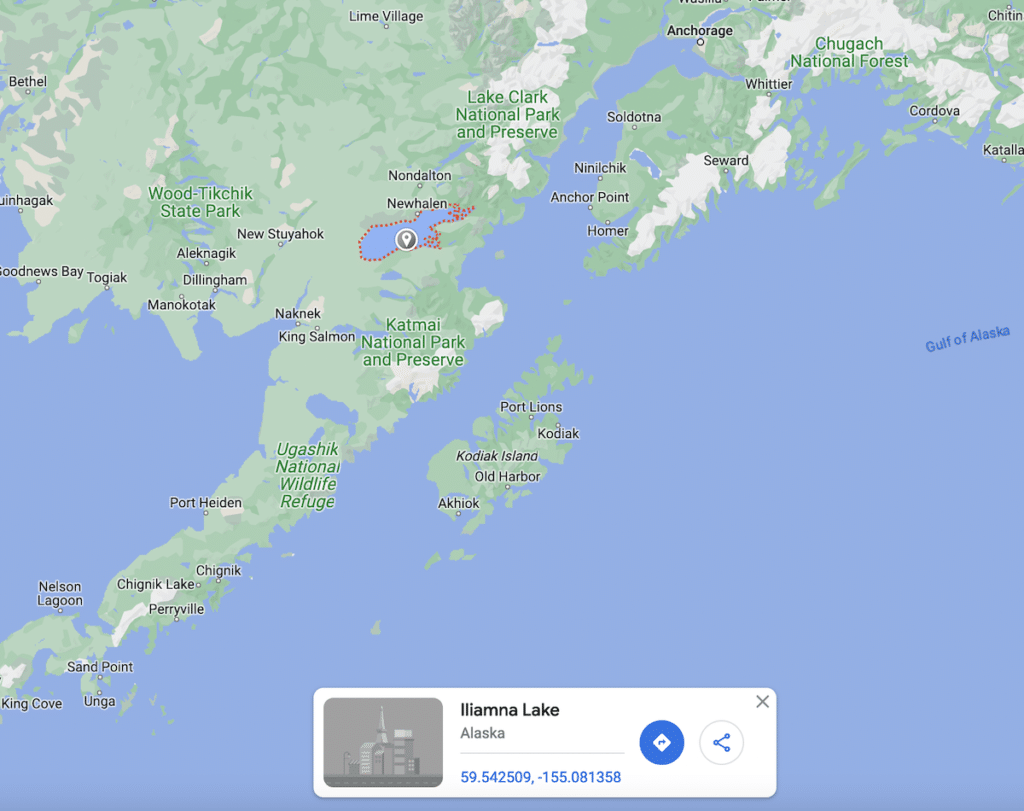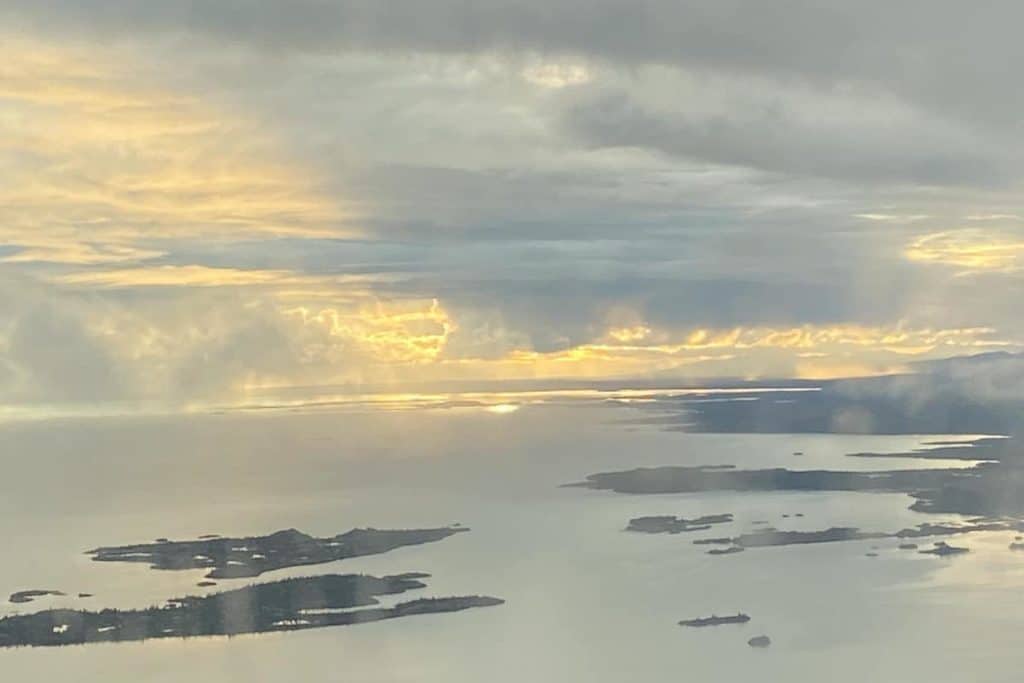Deep within the realms of myth and mystery lie creatures that defy explanation. They have lurked in the shadows of human imagination and folklore for generations.
These beings, known as crytids, ignite our curiosities and challenge our understanding of the world around us.
From Bigfoot roaming the North American forests to the elusive “Nessie” of the Scotland Loch, cryptids have captivated the minds of many worldwide.
Does Alaska harbor one of these elusive cryptids? In this article, we’ll explore and take a dive into the history of Alaska’s Lake Iliamna Monster.
Where Is Lake Iliamna

To truly understand the potential of the Lake Iliamna monster’s existence, we must first explore the lake itself. Nestled in a remote ecosystem on the northern coast of the Alaska Peninsula, Lake Iliamna stretches approximately 77 miles long and 22 miles wide reaching measured depths of over 1000 feet.
It is the largest freshwater lake in Alaska. Fed by the Kvichak River and connected to Bristol Bay and the Bering Sea, the lake is a thriving habitat for various fish and fauna.
Access to the lake is almost exclusively reliant on air travel. Potentially explaining why reported sightings weren’t gaining much attention until the 1940’s when pilots began spotting ‘something’ within the waters below.
This unique combination of the remote location, dimensions, and ecological connection fuels speculation about what could reside in the unexplored depths of Iliamna. Possibly some type of Iliamna Lake monster?
Sightings and Modern Descriptions Of The Iliamna Lake Monster
The creature’s likeness has been somewhat varied: influenced by cultural folklore, individual perspectives or simply the inevitable passage of time.
The modern consensus describes our cryptid as a large, serpent-like creature, approximately 30 feet in length with visible fins, a large head and smooth, metallic colored skin.
Accounts of the head have been said to be wolf-like or shark-like, and it is often noted the cryptid has the capability to dive and stay submerged without surfacing for prolonged periods of time.
Information about sightings wasn’t well circulated until after aviation made its way as the predominant form of travel into the region.
According to a timeline created in 2017 by the Alaska Sportsman Lodge and stories of sightings put together by writer Matt Bille from his article Lake Iliamna: My Favorite Natural Mystery, the following is an outline of some of the more notable sightings and events.

1942: Babe Alyesworth and Bill Hammersley report seeing a large, dull, aluminum-colored fish from their plane. Alsworth described them as having fish-like tails and elongated bodies.
1959: Cryptozoology enthusiast Tom Slick hired Alyesworth to conduct an aerial search of the lake, but nothing was sighted.
1963: “Noteworthy” but unnamed biologist reports seeing a 25-30 foot fish from overhead and in the estimated 10 minutes of observation it did not come up for air.
1967: Alaska missionary Chuck Crapuchettes reports seeing the monster while flying overhead in his float plane. He spotted a large animal in the water and attempted to radio someone on the ground for visual confirmation. No one was able to arrive in time.
One of his friends attempted to catch the animal he saw. Using a 5/16 stainless steel cable he put #2 tuna hooks on it and baited them with caribu meat, then tied it off on the struts of the floatplane and waited. He was sat, drifting on one of the floats of the plane when suddenly the plane was jerked, and he was thrown into the water.
The plane was towed off as he made his way to shore. He walked for miles as his plane pulled around the lake. When he recovered the plane, three of the cables were missing and of the one that remained the large 8-9 inch hook was completely straightened.
1977: Pilot Tim LaPorte and two passengers, flying over Pedro Bay (on the northern tip of Lake Iliamna), spot a 12-14 foot fish on the surface. As the plane approached closer the large fish dove down in a “big arching splash,” revealing a vertical tale.
1987: Resident Verna Kolyaha reported seeing a large black fish with a white stripe down its fin.
1988: Several locals report a similar sighting of a large black fish with a fin swimming near the surface.
2017: Kakhonak village residents saw a creature, about a mile offshore, they estimated was 50-60 feet in length. The witnesses state it blew like a whale and had smaller ones following along behind it.
For centuries, numerous sightings have been reported of a giant fish-like creature in the area. This idea of a lake monster is so believed that often it gets the credit for those who have gone missing on the waters of Iliamna.
Theories & Cryptozoological Speculation
With the lake’s connection to Bristol Bay and the Bering Sea, theories have emerged as to the possibility of various aquatic life forms making their way into the lake and sightings of which have become the subject of legend.
History Channel’s show, Missing In Alaska (Season 1 Episode 12), covers the story of a missing Kayaker who some believe met his fate by the hand, or fin, of the storied Lake Monster.
In the episode, they sit down in Anchorage with marine biologist John Parlier, who shares his thoughts on the legend of the Iliamna Lake monster.
“The most exciting possibility would be a Plesiosaur. That is known by the fossil record to have died out about 70 million years ago. They are reptiles, which means they were air breathers. They would need to surface to breathe and I think a creature of that size having to surface on a regular basis would still be much more visible.”
Could our monster be a surviving remnant of a prehistoric animal that has since adapted to survive in the sea like environment of the lake? This question keeps the attention of cryptozoologists and enthusiasts alike.
When asked about other theories, he replied, “Other potential organisms are the Beluga Whale. Problems with those – they’re very surface oriented. A new theory is this Oarfish…problem being, for them to enter freshwater would mean an incredible change in their physiology which they cannot do. They would die in the time it took them to enter the lake.”
Oarfish have been notoriously rare to spot. The first to be observed live was not until 2001. Stated to have “a worldwide range” and with reports that they are capable of reaching 56 feet and nearly 600 pounds in weight, could an oarfish be our elusive Iliamna Lake Monster?
In the interview, Parlier states, “The fish I am most interested in is this White Sturgeon. They are native to all of the pacific coast. These have been known to reach well over 1000 pounds. And you know, these are very migratory fish…they like to investigate a new habitat as it were.”
While White Sturgeon do offer an intriguing explanation, it remains unconfirmed they reside in the lake.
Seals may be held responsible for some of these sightings, as Lake Iliamna is one of five known locations of freshwater Harbor Seals.

Parlier mentions, “There have been times when seals will pod up and be on the surface in a large group and that’s been one case where a man thought for sure he saw a sea monster moving away from his boat. The way they were moving, it looked like a serpent in the surface.”
It has been confirmed in recent years, that these Harbor Seals reside within the region of the lake year-round. Perhaps from the perspective of a small boat these pod ripples startle onlookers and fuel imagination.
The interview concludes with Mr. Parlier being asked if he knows of any eyewitnesses they could speak to. He suggests they reach out to resident John Chamberlain, who the biologist stated appears to be a credible witness.
They meet with Mr. Chamberlain, who says he was on the north end of the lake kayaking when he noticed ripple in the water moving towards his left side. As it approached closer his boat was suddenly rammed with force. He lowered his paddle into the water to steady himself but when he did, he “felt a jerk on it” and when the paddle was pulled from the water there was a large piece missing. It appeared as if a bite was taken from it.
If this story is proven true, White Sturgeon can be ruled out as the possible culprits, as they do not have teeth.
Another intriguing possibility lies within the stories from Tlingit legend of the sea wolf. Even more intriguing is the stories have a real-world counterpart, the Coastal Gray Wolf.
These wolves can range from southern Alaska all the way to south Vancouver Island and have adapted to live predominately on seafood. They can swim for miles offshore and have been spotted as far as 7 miles from land. (2016, Talmazan, National Geographic).
This ecological connection adds intrigue to the ancient tales told by the indigenous communities along the lake. Could centuries old fisherman out on the vastness of the lake have spotted a sea going wolf swimming miles from shore and after telling and retelling of the tale it became this curious cryptid?
Gonakadet: The Legend and Tales
Lesser known than other famous cryptid counterparts, the legend of the Lake Iliamna Monster has endured for generations in Alaska.
Though, before it was the elusive monster playfully referred to as “Illie,” it was known to the natives as Gonakadet.
The Tlingit people are often cited as being the earliest to mention this creature and several versions of the legend exist, as it has a long and varied oral history.
The following is a condensed version of the story, published in a collection of Tlingit stories originally told by chief Katishan of Kaasx’agweid of Wrangell and reported by H. P. Corser in 1904 (1864-1936, Legends of Chief Shakes’ Totems, The Ko-na-ka-det)
A man married a “high caste” girl from another town. He had a bad reputation as a gambler, and this didn’t sit well with his new mother-in-law. She’d often harp on him about how little she thought of him.
To keep the peace, he built their hut at the back of the village near the lake. He had heard of a monster living in the lake and thought of proving himself by defeating the beast, so he built a trap to catch it.
With the use of a deadfall trap he killed the monster and donned its skin. Much to his surprise, by wearing its skin, he was now able to swim about in the water as if he himself were a fish. He told his wife of his adventures and asked that she keep it secret, especially from her mother.
One day, famine struck their village. He revealed to his wife the gifts the skin could provide but that its power required he must always be home ‘before the raven’s call.’ If he hadn’t returned by the call of the raven, it would most certainly mean his death.
That evening, he caught a salmon and placed it out front of his mother-in-law’s home for her to find the following morning. As was custom during a famine, the bounty was shared with the village, but when she found it, she claimed all the credit for having secured the fish.
She then predicted that the following day there would be two halibut. This went on and the predictions and offerings escalated.
The man would sleep during the day, tired from his evenings of donning the skin and hunting to fulfill her prophecy and provide for the village. The tired husband was berated by the mother-in-law who had said, “Imagine men sleeping all day when there is a famine. If it were not for me going around picking up dead fish the whole village would starve!”
With the predictions fulfilled daily, the mother-in-law requested to be honored as the village shaman. This was granted as they had all bore witness to her abundance.
She continued to bring shame on the husband, calling him things like lazy and the “Sleeping Man.” The man and his wife simply laughed at her arrogance.
The predictions reached their greatest height when the mother, now shaman, predicted two whales for the following morning. The husband shared with his wife, perhaps fearing the evenings challenge, “If I am found dead in this skin, put me along with the skin in the place where I used to hide it, and you will get help.”
One morning the wife heard the call of the raven but her husband had yet to return home. She began to cry, alerting the other villagers who followed her cries to the shore.
The mother-in-law now stood, along with the rest of the village, by the water to see two whales and a monster lying dead between them on the beach. The daughters cry over the monster’s body confused the people, until she requested help opening the mouth of the creature.
Shocked to see the face of her husband within its mouth, all assumed, “He must have been killed by that monster.”
As her husband requested, and aided by villagers, his body was laid to rest in the skins hiding spot. While her husband’s final request was being carried out, the villagers saw the very large trap and tools used to kill the lake monster. It was then they finally learned the truth.
Word spread and all went to see for themselves that the Sleeping Man was not a lazy husband, but a savior who kept them all from starvation. All the villagers came to pay their respects to the fallen man. That is, all but the mother-in-law, who is said to have died of shame.
From there forward, he was referred to as “Konakadet.”
Every night the wife would visit and mourn him. Until one night, when out by the tree, she saw a ripple in the water and heard her husbands voice call, “Get on my back and hold tight.” She grabbed on and began her new life beneath the water.
It is believed that Gonakadet’s children grow to be the “Daughters of the Creek.” They are said to stand at the head of every stream and bring luck to those that see them. This is why many believe seeing their father, Gonakadet, must also bring luck.
While many chose to believe a wild sighting of the monster brings luck, there are other iterations of the story that see the man punished for donning the skin of the creature.
He was banished to become the very thing he hunted, the creature itself. With the head of a wolf and the body of a whale, the sea wolf legend Gonakadet came to be. (2011, Gonakadeit the Monster).
Did the banishment from life on land harden the once man? Is Gonakadet angry and trapped within the waters? Does it roam the lake, dragging to the depths anyone with the misfortune of crossing its path?
Is The Iliamna Lake Monster Fact or Fiction? Or Somewhere Between?

In 1980, the Anchorage Daily News once offered a $100,000 reward to anyone who could come forward and present clear evidence of the creature.
This enticed the public; however, the reward was never collected.
This allure of the unknown beneath Lake Iliamna’s surface continues to attract researchers, cryptozoologists, and curious adventurers alike. Though concrete evidence may be scarce, the complexities of Alaska and the ecosystems within it leave much room for discovery.
The Lake Iliamna Monster remains a mysterious and captivating part of Alaskan folklore.
Director of Operations at the Heatherly Homefront, where the Force is strong, and so is the coffee. Alaska raised me with its wild flair, and though life’s plot twists have me presently in a different time zone, those Alaskan mountains will forever hold my heart hostage.
These days, I spend most of my time teaching my young padawans the ways of the Universe and attempting to keep my indoor plants alive. Though, when gifted with any measure of free time I fill it making something with my hands. I love to craft and create in any form, and always jump at the opportunity to try something new.
